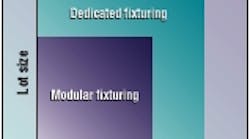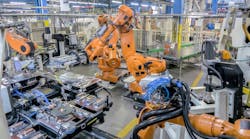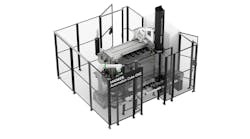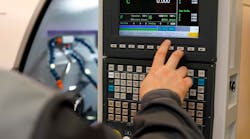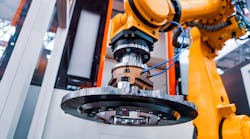Small-to-medium sized jobs demand the accuracy, versatility, and repeatability of flexible part fixturing systems.
Choosing between modular and dedicated fixturing for a particular job depends on how regularly the job will run, not just lot size.
Hilma recently introduced three new clamping devices for short or long production runs. These devices handle multiple configurations and sizes.
A Hilma flexible fixturing setup, vertically mounted in a Maxim machining center, provides high accuracy and repeatability.
In this Hilma flexible fixture, two separate hydraulic lines to each pallet — one pressure line and one return line — permit numerous separate clamping valves per tooling block.
As the trend towards smaller lot sizes and higher accuracy parts continues, many manufacturers are finding that dedicated workholding systems just don't provide the versatility they need. Modular systems, on the other hand, are best suited to small quantities or infrequent production runs. These and other flexible fixturing systems not only clamp accurately and consistently, but allow multiple machining operations to be performed in one setup, often slashing both production time and cost.
According to the Carr Lane Roemheld Mfg. Co., St. Louis, flexible fixtures usually combine basic tooling plates and blocks with precision-machined vises. Quickly assembled into different module configurations, they readily adapt to medium quantities of related families of parts. Combining fixtures on fixturing blocks and cubes in a machining center, these families of parts can also be machined at the same time.
The company's Hilma Division, for example, makes flexible fixturing systems specifically for small and medium-sized lots. "Our systems answer manufacturing demands for efficient quick-change tooling, while providing a high degree of accuracy," says Max Saunders, Hilma general manager.
The Hilma Division generally incorporates hydraulic power workholding elements to shorten setup and handling times.
Comparing fixture systems
Carr Lane Roemheld believes that companies look at a number of factors before deciding on a workholding system. Basically, fixturing costs include the investment needed to create the workholder, maintenance between runs, storage, and the cost of repeat usage. For a true comparison, companies should consider lot sizes, the number of times a job repeats, the life expectancy of the fixture, and so forth.
Modular systems have reusable parts, so component cost should be amortized over the system's typical lifetime by dividing total component cost by 100. Once initial costs are established, further cost comparison suggests the most efficient type of fixturing for a particular operation based on the overall cost per part. Each type offers advantages in some areas, reports Carr Lane Roemheld.
The company suggests using the following formula to figure the total cost to manufacture a given part:
Run cost is the cost of labor to produce a part. Generally, run costs for dedicated and modular fixturing are about the same, while power workholding lowers labor costs by improving cycle time and reducing scrap.
Setup cost is the labor cost to retrieve a fixture, set it up on a machine, and return it to storage after use. Since dedicated fixturing and power workholding are faster to set up, they create lower cost than modular fixturing, which requires assembly.
Lot size is the average quantity manufactured each time the fixture is set up.
Initial Tooling cost is the total of labor and materials to design and build a fixture. Here, modular fixturing is cheapest because parts are reused, while the more complex power workholding systems initially cost more.
Total quantity over tooling lifetime is the lesser of the total anticipated production quantity or the quantity that can be produced before the tooling wears out. Generally speaking, as quantities increase, the efficiency of power workholding yields the lowest cost per part.
System proves up to the test
One need search no further than Carr Lane Roemheld's parent company, Carr Lane Mfg. Co., to see the benefits of flexible fixturing. The company uses Hilma systems to manufacture high-precision angle brackets faster than previously possible. Using Hilma vises and its own tooling blocks on a Cincinnati Milacron Maxim horizontal machining center, Carr Lane mills angle brackets with accuracy of +0.0000/-0.0005. Four locating holes are held to ±0.0005 diameter and within ±0.0015 true position. These tolerances previously took seven machining steps and 8 min/part.
Machining time dropped to 3.8 min/piece because flexible fixturing eliminated five setups, along with five transport times and five queuing times.
The system's quick-change tooling also boosted production by allowing varied configurations to run on existing equipment. An entire system can be quickly assem-bled and reassembled with reusable clamping units to accommodate changing shapes and sizes of workpieces. Operators swap clamping units between machining centers and quickly "retool" by simply changing vise jaws.
"These systems have been very successful at solving the needs of today's manufacturers," Saunders says. "We've recently added several new products to the Hilma line to provide more options."
One of these new products is a compact quick-clamping system that provides fast action when used individually or in more complex fixtures. They are available in multiple configurations and sizes suitable for short or long production runs.
Hilma designed a new base and fixed-jaw for its NC clamping system. The changes improve stability and reliability in a variety of tooling, molding, and fixturing applications. The system's hydra-mechanical or fully powered units work vertically or horizontally as does a new universal clamp system.
All NC clamping systems can be quickly positioned on machine beds using the external clamping edges and keyways in their bases. Their surfaces and guideways are precision ground, and hydraulics are integrated into the slide for optimum protection against chips and dirt.
New mechanical double-clamping systems with a third-hand function mount on towers singly or in a series for clamping multiple workpieces. Ideal as reversible clamping devices, the all-steel designs work well in horizontal or vertical uses, and a fixed overall length maximizes working space.
With simple jaw changes, double clamping systems changeover rapidly and economically to accommodate prismatic or extruded workpieces, castings, and forgings. Clamping force can be preset with a torque wrench for reliable, repeatable clamping action.
Hilma combines four clamping units on a single base for its flexible fixturing cubes. Their one-piece steel body and integrated fixed jaws provide maximum stability and precision for increased production. Available in three base sizes, fixture cubes have clamping points positioned for machining of workpieces in one setup.
Intelligent fixturing on the horizon
Lamb Technicon Division of Unova Inc. is working on a project called the Intelligent Fixturing System. When completed, it will completely automate fixturing for high-volume production. The IFS will include a station that will resemble a machine-tool station, with a robot manipulator and fixture receiver. Once a fixture enters the station, it will be clamped and adjusted for machining.
The latest news on the flexible-fixturing front comes from Lamb Technicon Division of Unova Inc., Warren, Mich. The company has been working with General Motors, Ford, Chrysler, and Cummins Engine on an Advanced Technology Program funded by the National Institute of Standards and Technology. The Intelligent Fixturing System project aims to create the next generation of flexible fixturing systems for high-volume production of automotive parts.
Says Philip Szuba, Lamb's manager of R&D, "We are working with Pennsylvania State University, the University of Illinois, Georgia Tech, and the University of Michigan to develop sub-systems for our fixturing concept. Once these sub-systems are developed, Lamb will integrate, test, and de-bug the fixture configuration stations."
Szuba says that there are four basic sub-systems in the IFS concept: flexible clampings, a part locator, a micropositioner, and a software support system.
The flexible clamping system, when finished, should be able to clamp a very large family of parts in a single fixture. What will set this system apart, claims Szuba, is its rigidity. "In general," he explains, "increased flexibility means a decrease in rigidity, which is crucial to the machining operation. Our goal is flexibility while maintaining above-standard stiffness."
The part location system is intended to accurately define the part — whether it is an as-cast part or one that's already been machined — and sense its location. This might be done by touching it or possibly using a vision system, explains Szuba. "We think we can put the part into the fixture without hard locators, which are used in traditional fixturing."
Once a part is clamped and the system senses its location, a manipulator will line up the fixture with the machine axis. Szuba expects that actuators adjusting the entire pallet fixture to the correct location will comprise the manipulating sub-assembly.
When finished, a software support system will not only control the IFS, but also contain knowledge of pre-existing process models. With this data, says Szuba, the software can determine an optimum part clamping position.
Flexible workholding reduces setup time
Chick Workholding Solutions' Pneu-Dex is an indexable workholding system capable of holding up to eight parts in one setup.
According to the Dapra Corp., its Mono Quad workholding system can maximize a vertical machining center's production when used with an indexer.
Flexible fixturing systems often speed production by minimizing tool-change time and limiting work interruptions. This is because, in most cases, a single setup is housing multiple parts.
Dapra Corp., Bloomfield, Conn., recently introduced a workholding system designed for machining up to eight parts in one setup. According to the company, the Mono Quad System can maximize a vertical machining center's production when used with an indexer.
A low-profile clamping mechanism is well out of the way for maximum jaw machinability, and quick-change soft jaws are reversible. Eight in. of jaw travel accommodates more parts at each vise position. In addition, a telescopic cover protects the Mono Quad's precision lead-screw from chip damage. The system's hardened and ground steel guideways resist wear, are durable, and operate smoothly.
Another company, Chick Workholding Solutions Inc., Warrendale, Pa., also debuted an indexable system for vertical machining centers. It, too, can hold up to eight parts at one time.
The Pneu-Dex is lightweight and compact, with dimensions of 6023298 mm. It can be easily mounted in either the Xor Yaxis of most VMCs.
The system incorporates Chick Qwikchange machinable jaws, which can be converted into dedicated fixtures by machining a "nest" for the part directly into the jaw. The Pneu-Dex comes in two standard sizes — 300 and 400 mm — and comes completely assembled, with subplates and controls, ready to mount.
